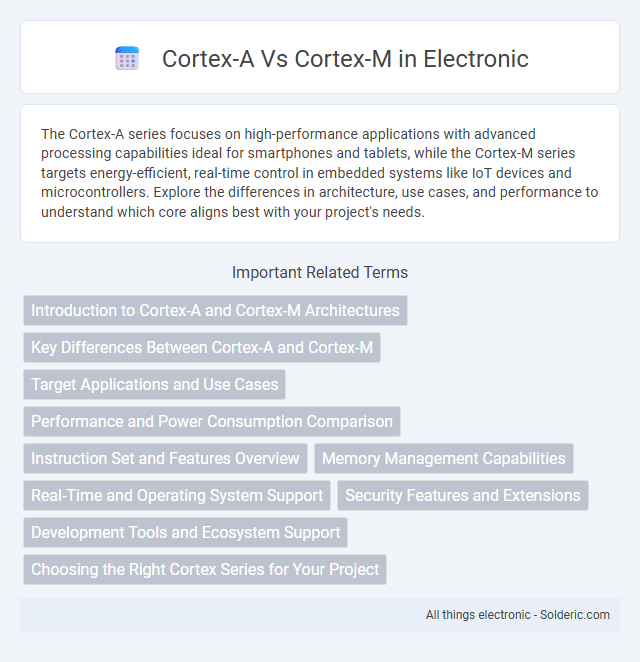The Cortex-A series focuses on high-performance applications with advanced processing capabilities ideal for smartphones and tablets, while the Cortex-M series targets energy-efficient, real-time control in embedded systems like IoT devices and microcontrollers. Explore the differences in architecture, use cases, and performance to understand which core aligns best with your project's needs.
Comparison Table
| Feature | Cortex-A | Cortex-M |
|---|---|---|
| Primary Use | Application processors (smartphones, tablets, laptops) | Microcontrollers (embedded systems, IoT devices) |
| Performance | High-performance, capable of running operating systems | Low-power, real-time control tasks |
| Instruction Set | ARMv7-A / ARMv8-A (AArch32 & AArch64) | ARMv6-M, ARMv7-M, ARMv8-M (Thumb-2) |
| Operating System Support | Supports complex OS: Linux, Android, Windows | Usually runs bare-metal or RTOS (FreeRTOS, ThreadX) |
| Power Consumption | Higher power consumption | Optimized for low power consumption |
| Memory Management | Includes MMU (Memory Management Unit) | Uses MPU (Memory Protection Unit) or no memory management |
| Cache | Usually has instruction and data caches | Typically minimal or no cache |
| Interrupt Handling | Advanced interrupt controller, supports SMP | Nested Vectored Interrupt Controller (NVIC) |
| Examples | Cortex-A53, Cortex-A72, Cortex-A78 | Cortex-M0, Cortex-M3, Cortex-M4, Cortex-M7, Cortex-M33 |
Introduction to Cortex-A and Cortex-M Architectures
Cortex-A and Cortex-M architectures are designed for different applications, with Cortex-A optimized for high-performance processing in smartphones, tablets, and other complex devices, while Cortex-M targets low-power, real-time embedded systems such as IoT and microcontrollers. Cortex-A cores feature advanced memory management units (MMUs) supporting operating systems like Linux, offering multitasking and virtual memory capabilities. Cortex-M cores prioritize energy efficiency and deterministic interrupt handling with simplified memory protection units (MPUs), making Your choice crucial depending on the required performance and power constraints of your project.
Key Differences Between Cortex-A and Cortex-M
Cortex-A processors are designed for high-performance applications, featuring complex instruction sets and support for operating systems like Linux, making them ideal for smartphones and tablets. Cortex-M processors prioritize low power consumption and real-time processing with simpler instruction sets, commonly used in embedded systems and microcontroller applications. Your choice between Cortex-A and Cortex-M depends on the required computational power, energy efficiency, and application complexity.
Target Applications and Use Cases
Cortex-A processors are designed for high-performance applications such as smartphones, tablets, and multimedia devices, where running complex operating systems like Linux or Android is essential. Cortex-M processors target embedded systems requiring low power consumption and real-time performance, including IoT devices, automotive control systems, and wearables. Your choice between Cortex-A and Cortex-M depends on the need for computational power versus energy efficiency and real-time responsiveness.
Performance and Power Consumption Comparison
Cortex-A processors deliver higher performance with advanced features like out-of-order execution and higher clock speeds, making them ideal for complex applications and operating systems. Cortex-M processors prioritize low power consumption and efficient real-time processing, featuring simpler architecture that enables longer battery life in embedded and IoT devices. Your choice depends on whether performance or energy efficiency is the critical factor for your application requirements.
Instruction Set and Features Overview
Cortex-A processors utilize the ARMv7-A or ARMv8-A instruction sets, supporting advanced features like virtual memory, out-of-order execution, and enhanced multimedia processing, making them ideal for complex operating systems and high-performance applications. Cortex-M processors rely on the ARMv7-M or ARMv8-M instruction sets, designed for deterministic, low-latency real-time tasks with simplified interrupt handling and power efficiency. Your choice between Cortex-A and Cortex-M depends on whether you need high computational power and OS support or optimized real-time performance with minimal footprint.
Memory Management Capabilities
Cortex-A processors feature advanced memory management units (MMUs) supporting virtual memory and complex operating systems, enabling efficient handling of large address spaces and multitasking environments. Cortex-M processors utilize memory protection units (MPUs) designed for lightweight control and real-time applications, providing basic memory protection without the overhead of virtual memory management. This distinction makes Cortex-A ideal for high-performance, OS-driven applications, while Cortex-M excels in deterministic, low-latency embedded systems.
Real-Time and Operating System Support
Cortex-M processors are designed for real-time applications requiring deterministic interrupt handling and minimal latency, making them ideal for bare-metal or real-time operating systems (RTOS) like FreeRTOS and Zephyr. Cortex-A processors support more complex operating systems such as Linux and Android, providing advanced memory management and multitasking capabilities but with less predictable real-time behavior. Your choice depends on whether strict real-time performance or advanced OS features are critical for your embedded project.
Security Features and Extensions
Cortex-A processors incorporate advanced security extensions such as TrustZone technology, enabling hardware-isolated secure and non-secure worlds ideal for running rich operating systems with secure enclaves. Cortex-M processors feature TrustZone for Cortex-M, offering fine-grained memory protection and secure interrupt handling tailored for embedded and IoT applications requiring low-latency security. Both architectures support ARMv8-M Security Extensions, enhancing code integrity, secure boot, and cryptographic acceleration to defend against modern cyber threats.
Development Tools and Ecosystem Support
Cortex-A processors benefit from extensive development tools and robust ecosystem support, including advanced IDEs like ARM Development Studio and wide third-party software compatibility, ideal for complex applications requiring operating systems such as Linux or Android. Cortex-M processors offer streamlined toolchains optimized for real-time embedded development, with support from ARM Keil MDK, IAR Embedded Workbench, and integrated debugging tools tailored for microcontroller-based applications. The ecosystem for Cortex-M emphasizes low-power, deterministic performance and includes extensive middleware libraries and RTOS options, facilitating rapid prototyping and efficient firmware development.
Choosing the Right Cortex Series for Your Project
Cortex-A processors excel in high-performance applications requiring complex operating systems and multimedia capabilities, making them ideal for smartphones and tablets. Cortex-M series targets low-power, real-time embedded systems, perfect for IoT devices and microcontrollers demanding efficient energy consumption and fast interrupt handling. Selecting the right Cortex series depends on evaluating project requirements for processing power, energy efficiency, and application complexity.
Cortex-A vs Cortex-M Infographic

 solderic.com
solderic.com